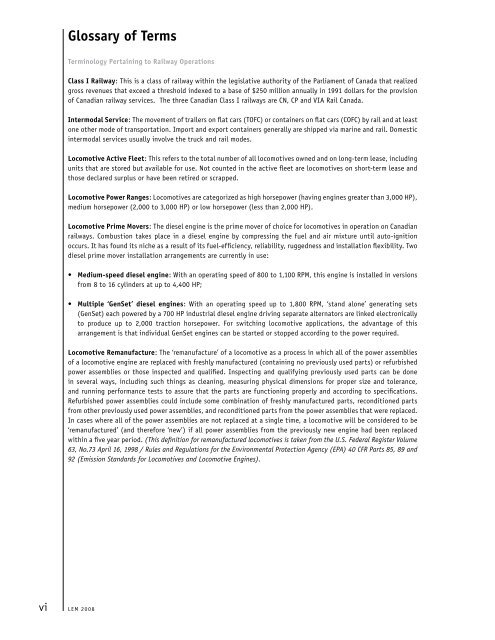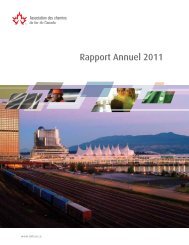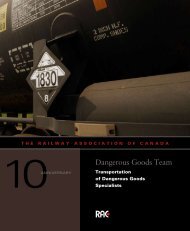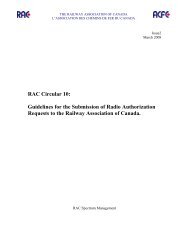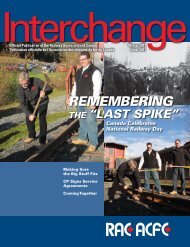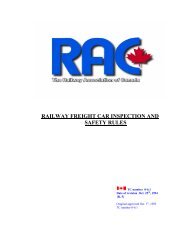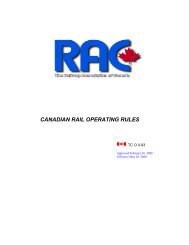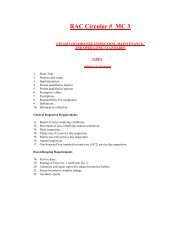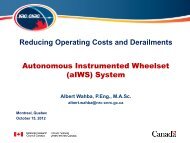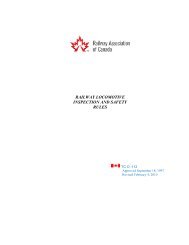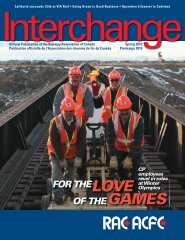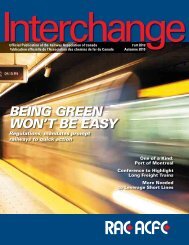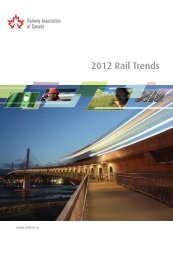Locomotive Emissions Monitoring Program - Railway Association of ...
Locomotive Emissions Monitoring Program - Railway Association of ...
Locomotive Emissions Monitoring Program - Railway Association of ...
Create successful ePaper yourself
Turn your PDF publications into a flip-book with our unique Google optimized e-Paper software.
Glossary <strong>of</strong> Terms<br />
Terminology Pertaining to <strong>Railway</strong> Operations<br />
Class I <strong>Railway</strong>: This is a class <strong>of</strong> railway within the legislative authority <strong>of</strong> the Parliament <strong>of</strong> Canada that realized<br />
gross revenues that exceed a threshold indexed to a base <strong>of</strong> $250 million annually in 1991 dollars for the provision<br />
<strong>of</strong> Canadian railway services. The three Canadian Class I railways are CN, CP and VIA Rail Canada.<br />
Intermodal Service: The movement <strong>of</strong> trailers on flat cars (TOFC) or containers on flat cars (COFC) by rail and at least<br />
one other mode <strong>of</strong> transportation. Import and export containers generally are shipped via marine and rail. Domestic<br />
intermodal services usually involve the truck and rail modes.<br />
<strong>Locomotive</strong> Active Fleet: This refers to the total number <strong>of</strong> all locomotives owned and on long-term lease, including<br />
units that are stored but available for use. Not counted in the active fleet are locomotives on short-term lease and<br />
those declared surplus or have been retired or scrapped.<br />
<strong>Locomotive</strong> Power Ranges: <strong>Locomotive</strong>s are categorized as high horsepower (having engines greater than 3,000 HP),<br />
medium horsepower (2,000 to 3,000 HP) or low horsepower (less than 2,000 HP).<br />
<strong>Locomotive</strong> Prime Movers: The diesel engine is the prime mover <strong>of</strong> choice for locomotives in operation on Canadian<br />
railways. Combustion takes place in a diesel engine by compressing the fuel and air mixture until auto-ignition<br />
occurs. It has found its niche as a result <strong>of</strong> its fuel-efficiency, reliability, ruggedness and installation flexibility. Two<br />
diesel prime mover installation arrangements are currently in use:<br />
• Medium-speed diesel engine: With an operating speed <strong>of</strong> 800 to 1,100 RPM, this engine is installed in versions<br />
from 8 to 16 cylinders at up to 4,400 HP;<br />
• Multiple ‘GenSet’ diesel engines: With an operating speed up to 1,800 RPM, ‘stand alone’ generating sets<br />
(GenSet) each powered by a 700 HP industrial diesel engine driving separate alternators are linked electronically<br />
to produce up to 2,000 traction horsepower. For switching locomotive applications, the advantage <strong>of</strong> this<br />
arrangement is that individual GenSet engines can be started or stopped according to the power required.<br />
<strong>Locomotive</strong> Remanufacture: The ‘remanufacture’ <strong>of</strong> a locomotive as a process in which all <strong>of</strong> the power assemblies<br />
<strong>of</strong> a locomotive engine are replaced with freshly manufactured (containing no previously used parts) or refurbished<br />
power assemblies or those inspected and qualified. Inspecting and qualifying previously used parts can be done<br />
in several ways, including such things as cleaning, measuring physical dimensions for proper size and tolerance,<br />
and running performance tests to assure that the parts are functioning properly and according to specifications.<br />
Refurbished power assemblies could include some combination <strong>of</strong> freshly manufactured parts, reconditioned parts<br />
from other previously used power assemblies, and reconditioned parts from the power assemblies that were replaced.<br />
In cases where all <strong>of</strong> the power assemblies are not replaced at a single time, a locomotive will be considered to be<br />
‘remanufactured’ (and therefore ‘new’) if all power assemblies from the previously new engine had been replaced<br />
within a five year period. (This definition for remanufactured locomotives is taken from the U.S. Federal Register Volume<br />
63, No.73 April 16, 1998 / Rules and Regulations for the Environmental Protection Agency (EPA) 40 CFR Parts 85, 89 and<br />
92 (Emission Standards for <strong>Locomotive</strong>s and <strong>Locomotive</strong> Engines).<br />
vi LEM 2008


